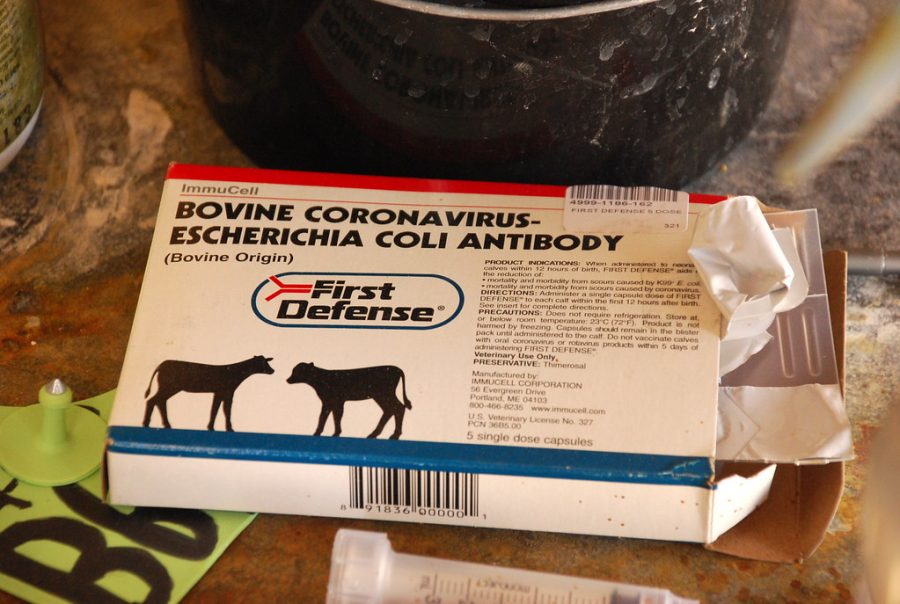Coping With The Coronavirus
The now infamous coronavirus originated from unsanitary human contact with livestock, leading to a mutation of the virus that affects humans. “Coronavirus and E. coli vaccine” by afagen is licensed under CC BY-NC-SA 2.0
The city of Wuhan, China is just west of Shanghai and a hub for business and transportation. The capital of the country’s Hubei province has a population of roughly 11 million people. Known for what the locals call “wet markets”, many people from the surrounding areas flock to the city on a weekly basis to buy and sell seafood, meat, and live animals. This allows customers to get their hands on locally raised livestock and fresh cuts of meat. However, a commonly voiced concern in regards to these markets is the lack of sanitation. Animals are usually slaughtered right in front of customers, with livestock right next to the freshly cut meat. Although it is convenient to do everything in one place, this does not bode well when it comes to preventing bacteria from spreading between humans and animals.
Zoonotic viruses, or viruses that spread from animals to people, have been responsible for multiple global outbreaks- the Swine Flu in 2009, Ebola in 2014, and Severe Acute Respiratory Syndrome (SARS) in 2003. The first case of the coronavirus has been traced back to a Wuhan wet market, where it has been concluded that livestock originally contracted the disease from bats. Once the animals containing the virus were slaughtered, the virus became airborne, and humans became susceptible to a certain mutation of the disease, which scientists have called “2019-nCoV”. The term “corona” means ‘crown’ in Spanish, meant to reference the sharp points found at the top of the cells of the virus. The 2019-nCoV version is actually related to SARS, as they are both types of coronaviruses and their origins are extremely similar. In response to the spread of the virus and backlash from the media, the original wet market in Wuhan has been shut down, and trade of live animals in the city has been banned.
The symptoms of the coronavirus are comparable to the common cold or influenza- they include a fever, cough, difficulty breathing, diarrhea, body aches, and even pneumonia. Once someone has become infected with the virus, up to two weeks can pass before symptoms begin to show. Contact with bodily fluids from the respiratory tract is the number one cause of the spread of the virus. As of now, 20 countries have been affected by the virus. At least 492 people in China have been killed, and 24,000 have been diagnosed. Many Americans that work in and travel to China frequently have been ordered to leave the country. The entire city of Wuhan has been quarantined, public transportation and schools have been shut down. Beijing and Hong Kong have become more strict about sanitation and tour groups as more people have been diagnosed with the disease.
The Chinese government has been under fire for not providing doctors with enough supplies or medication. In response to the backlash, China’s leader, Xi Jingping has promised to send medical personnel to highly affected areas. Converting spaces like hotels or office buildings to quarantined areas have helped to solve the problem of overcrowded hospitals. Despite his efforts, Jingping is resented by many Chinese citizens who feel that he and many other officials are “not out on the front line” during the country’s time of need. The general consensus is that the outbreak would have been less extreme if officials had taken action earlier. Most Lunar New Year festivities were cancelled in lieu of the nation’s medical emergency.
Airports in the United States and many other countries have begun to screen people from China for symptoms. This adds to the already chaotic atmosphere of most American airports. International travel is not the only thing being affected by the virus- many assembly lines and factories, including car manufacturers Hyundai, Ford, Tesla, and Nissan have been shut down due to staffing issues. There is also now a global shortage of medical masks, and many in affected areas have been advised not to wear them if they are healthy. Research has shown that the masks are more effective when worn by those who are sick than when worn by people who are not. Global relations have been strained by offers from the United States to help China with the epidemic. The response has been relatively vague and quiet- some Chinese officials blame the United States for what they have deemed a “global overreaction”. The two countries continue to negotiate trade deals while attempting to come to a consensus about what to do about the coronavirus. American officials will be arriving in China as part of a World Health Organization project within the next few days. There is still no shot for the coronavirus, but there is a test that can confirm whether or not someone is affected before they begin to show symptoms.
There have been 11 cases of the coronavirus confirmed in the US. Specifically, there have been six in California, two in Illinois, and one in Arizona, Massachusetts, and Washington. The only suspected case in North Carolina took place at an airport in Raleigh, the concern being that the passenger had passed through the city of Wuhan.The test was negative. More tests are currently underway, but many argue that we should shift our attention away from the coronavirus and in the direction of the flu.
There have been approximately 19 million cases of the flu and 10,000 flu-related deaths this flu season alone. Schools in Florida and Tennessee have closed down because of how sick the students and staff are. Why isn’t this widespread news? Most epidemics originate in the East, solely because of the highly concentrated population and limited resources. Animal-borne illnesses have proved to be a large problem over the past few decades, and this is still a concern. Scientists hypothesize that there are currently thousands of viruses still waiting to be identified in China. The threat of the coronavirus’ infiltration has sparked enough panic to overshadow any mention of the flu. At the very least, many of the world powers now share a common goal of preventing the spread of the disease.












